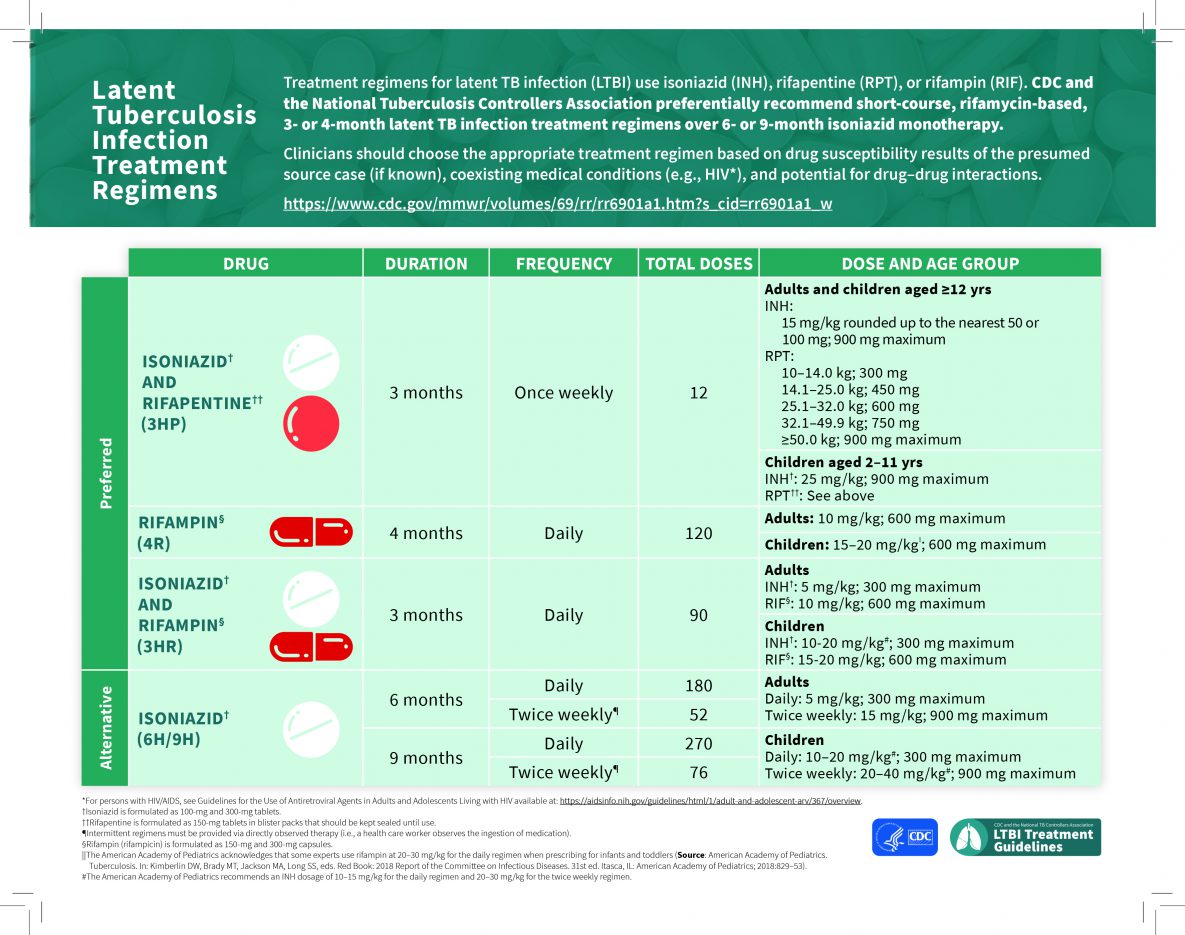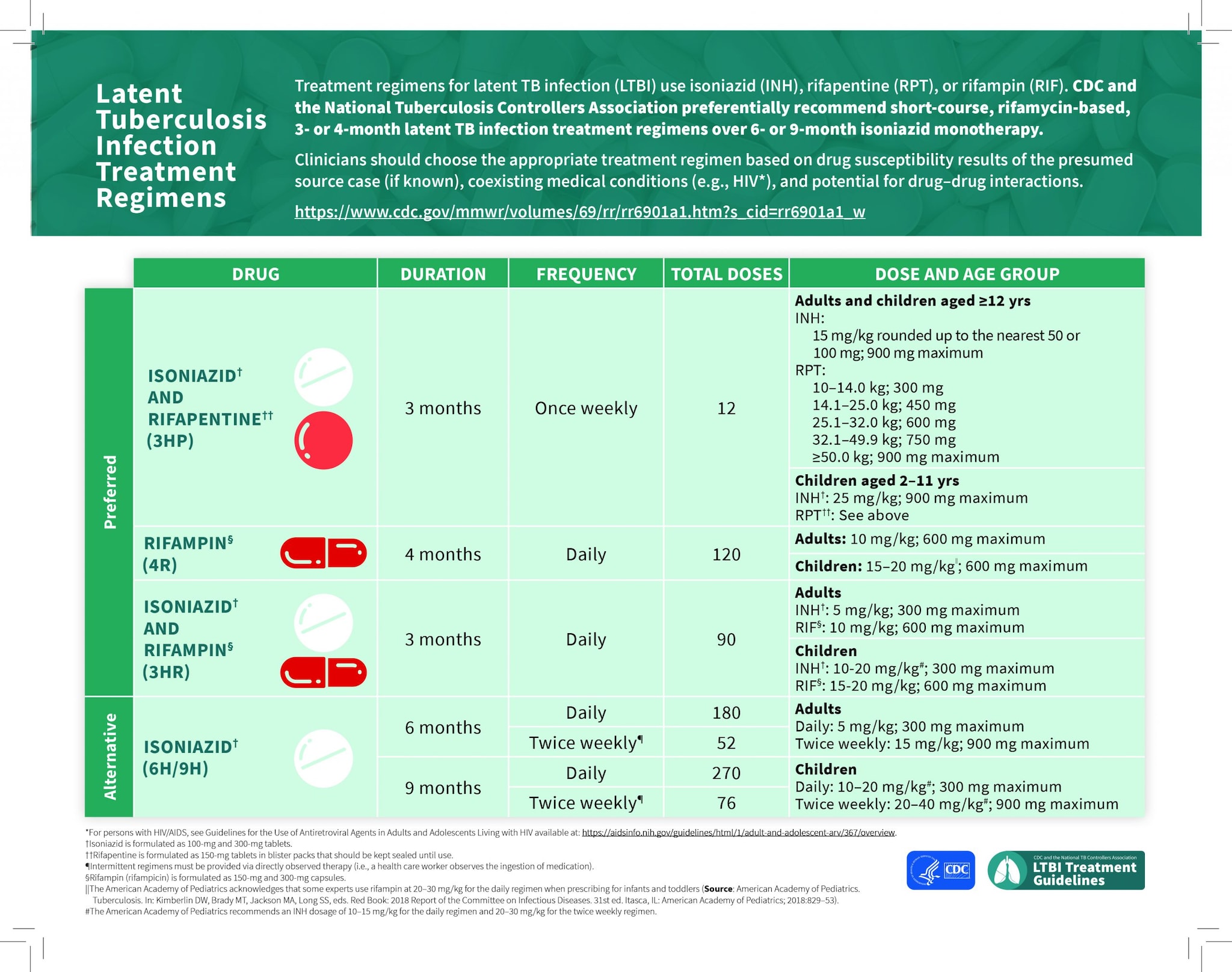Treating Latent Tuberculosis (TB) Infection with Short-Course Regimens
Latent TB Infection Can Be Treated to Prevent TB Disease.
Learn about latent TB infection treatment guidelines from the Centers for Disease Control and Prevention (CDC) and National Tuberculosis Controllers Association (NTCA).
Treating Latent TB Infection Prevents TB Disease
Not everyone infected with TB bacteria becomes sick. As a result, there are two types of TB conditions: TB disease and latent TB infection. People with latent TB infection have TB bacteria in their bodies, but they do not feel sick, do not have symptoms, and cannot spread TB bacteria to others. Sometimes, especially in people who have weakened immune systems, the bacteria can become active, multiply, and cause TB disease. Treatment can prevent people with latent TB infection from getting sick with TB disease.
Treatment of latent TB infection is essential to controlling and eliminating TB in the United States because it substantially reduces the risk that latent TB infection will progress to TB disease. There are several treatment regimens recommended in the United States for latent TB infection.

CDC and the National TB Controllers Association published guidelines for the treatment of latent TB infection.
Updated Latent TB Infection Treatment Guidelines
CDC and the National Tuberculosis Controllers Association (NTCA) published latent TB infection treatment guidelines. CDC and NTCA preferentially recommend short-course, rifamycin-based, 3- or 4-month latent TB infection treatment regimens over 6- or 9-month isoniazid monotherapy.
Highlights from the guidelines include:
- To treat latent TB infection, CDC and NTCA preferentially recommend the following options:
- Three months of once-weekly isoniazid plus rifapentine (3HP). 3HP is strongly recommended for adults and children older than 2 years, including HIV-positive persons.
- Four months of daily rifampin (4R). 4R is strongly recommended for HIV-negative adults and children of all ages.
- Three months of daily isoniazid plus rifampin (3HR) is conditionally recommended for adults and children of all ages and for HIV-positive persons.
- Short-course latent TB infection treatment regimens are effective, safe, have a lower risk of hepatotoxicity, and have higher completion rates than longer 6 to 9 months of isoniazid monotherapy (6H/9H).
- If short-course treatment is not a feasible or available option (for example, due to drug interactions with rifamycins), CDC and NTCA recommend six or nine months of daily isoniazid (6H/9H) as alternative, effective latent TB infection treatment regimens.
Choosing the Right Latent TB Infection Treatment Regimen
More than 80% of people who develop TB disease in the United States each year get sick from longstanding, untreated latent TB infection. The availability of short-course regimens enables providers to treat people who are at risk for TB disease.
Clinicians can work with patients to determine the best latent TB infection treatment regimenpdf icon, prescribe shorter regimens, and provide support and resources to help patients complete latent TB infection treatment successfully. Clinicians should choose the appropriate treatment regimen based on the following:
- drug susceptibility results of the presumed source case, if known;
- coexisting medical conditions; and
- potential for drug–drug interactions.
Clinicians may choose to administer latent TB infection treatment through directly observed therapy (DOT) or self-administered therapy (SAT) based on local practice, individual patient attributes and preferences, and other considerations including risk of progression to severe forms of TB disease.
When treating persons with HIV/AIDS for latent TB infection, clinicians should review the guidelinesexternal icon for the use of antiretroviral agents in adults and adolescents living with HIV.
CDC has tools and resources for clinicians, including a latent TB infection treatment tablepdf icon and FAQs for clinicians and pharmacists. The online latent TB infection resources hub is a one-stop shop for resources related to education and training, guidelines, testing and diagnosis, infection control and prevention, and treatment.
To learn more about latent TB infection treatment, contact your state or local TB program or visit CDC’s tuberculosis website. Education materials can be found through CDC, the TB Centers of Excellence for Training, Education, and Medical Consultation, and the CDC’s Find TB Resources website.
For Providers:
- Guidelines for the Treatment of Latent Tuberculosis Infection: Recommendations from the National Tuberculosis Controllers Association and CDC, 2020
- Latent TB Infection Treatment Regimens
- Latent TB Infection Treatment Tablepdf icon
- Latent Tuberculosis Infection: A Guide for Primary Health Care Providers pdf icon
- Latent TB Infection Testing and Treatment: Summary of U.S. Recommendationspdf icon
- Latent TB Infection Resources Hub
- State TB Control Offices
- National Tuberculosis Controllers Association (NTCA) Testing and Treatment of Latent Tuberculosis Infection in the United States: Clinical Recommendationsexternal icon
For Patients:
- TB: General Information (Fact sheet)
- TB Can Be Treated (Fact sheet)
- Staying on Track with TB Medicinepdf icon (Pamphlet)
- 12-Dose Regimen for Latent TB Infection – Patient Education Brochure
- 12-Dose Regimen for Latent TB Infection – Medication Tracker and Symptom Checklistpdf icon
- 4 Months of Daily Rifampin (4R) Regimen for Latent TB Infection – Medication Tracker and Symptom Checklist pdf icon[PDF – 288 KB]
- 3 Months of Daily Isoniazid plus Rifampin (3HR) Regimen for Latent TB Infection – Medication Tracker and Symptom Checklistpdf icon

